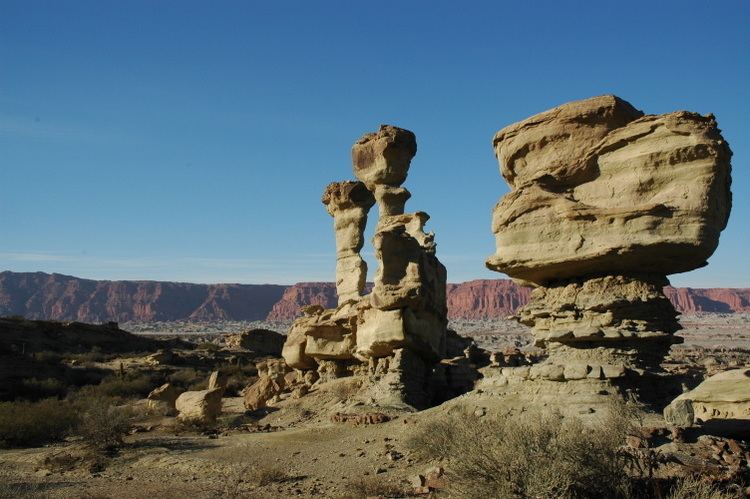Type Natural | ||
 | ||
Area 60,370 ha (233.1 sq mi) Established November 3, 1971 (1971-11-03) Official name Ischigualasto / Talampaya Natural Parks | ||
Ischigualasto Provincial Park (Spanish: Parque Provincial Ischigualasto), also called Valle de la Luna ("Valley of the Moon" or "Moon Valley"), due to its otherworldly appearance, is a provincial protected area in the north-east of San Juan Province, north-western Argentina, limiting to the north with the Talampaya National Park, in La Rioja Province. Both areas belong to the same geological formation, the Ischigualasto Formation (sometimes Ischigualasto-Talampaya Formation) Established on 3 November 1971, the park has an area of 60,370 ha (603.7 km2; 233.1 sq mi)
Contents
In 2000 UNESCO included Ischigualasto and Talampaya National Park among its World Heritage Sites.
History
The most accepted hypothesis gives the name "Ischigualasto" a Quechua origin, meaning "dead land", although some scholars have proposed Diaguita or Huarpe roots.
The first paleontological description of Ischigualasto dates from 1930. In 1941 the area was studied in more detail, which led to the discovery of 70 species of fossil plants. The region received for the first time the name Valle de la Luna in 1943, in a publication edited by the Automobil Club Argentino. That year, Dr. Ángel Cabrera of University of La Plata described the traversodontid Exaeretodon—the first cynodont found in Ischigualasto—after samples sent by a geologist prospecting for coal on behalf of an Argentine mining company.
Academic work and geological prospecting proceeded slowly until 1958, when Dr. Alfred Sherwood Romer, a Harvard University expert in ancient mammals, discovered several rich fossil beds which he described as "extraordinary".
Description
Most of the park lies within the Valle Fértil Department, with a minor part in the Jachal Department of San Juan, at an altitude of about 1,300 m (4,300 ft) amsl. The park is part of the western border of the Central Sierras, and it features typical desert vegetation (bushes, cacti and some trees) which covers between 10 and 20% of the area. The climate is very dry, with rainfall mostly during the summer, and temperature extremes (minimum −10 °C (14 °F), maximum 45 °C (113 °F)). There is a constant southern wind with a speed of 20–40 km/h (12–25 mph) after noon and until the evening, sometimes accompanied by the extremely strong Zonda wind.
Paleontology
The Ischigualasto Formation contains Late Triassic (Carnian) deposits (231.4 -225.9 million years before the present), with some of the oldest known dinosaur remains, which are the world's first with regards to quality, number and importance. It is the only place in the world where nearly all of the Triassic is represented in an undisturbed sequence of rock deposits. This allows for the study of the transition between dinosaurs and ancient mammals; research is ongoing.
In the Carnian this area was a volcanically active floodplain dominated by rivers and had a strongly seasonal rainfall. Petrified tree trunks of Protojuniperoxylon ischigualastianus more than 40 m (130 ft) tall attest to a rich vegetation at that time. Fossil ferns and horsetails have also been found.
Rhynchosaurs and cynodonts (especially rhynchosaur Hyperodapedon and cynodont Exaeretodon) are by far the predominant findings among the tetrapod fossils in the park. A study from 1993 found dinosaur specimens to comprise only 6% of the total tetrapod sample; subsequent discoveries increased this number to approximately 11% of all findings. Carnivorous dinosaurs are the most common terrestrial carnivores of the Ischigualasto Formation, with herrerasaurids comprising 72% of all recovered terrestrial carnivores. Dinosaurs of Ischigualasto Formation include early samples of the two major lineages of dinosaurs (ornithischians and saurischians). The carnivorous archosaur Herrerasaurus is the most numerous of these dinosaur fossils. Another important putative dinosaur with primitive characteristics is Eoraptor lunensis, found in Ischigualasto in the early 1990s.
Dinosaurs
The fossils of an undescribed species of theropod are present in San Juan Province.
